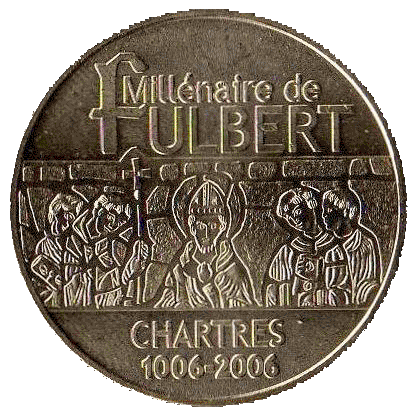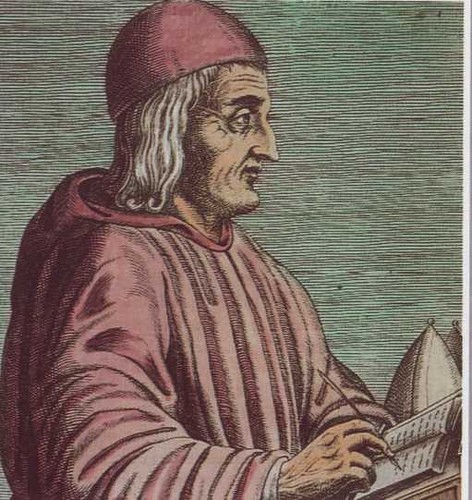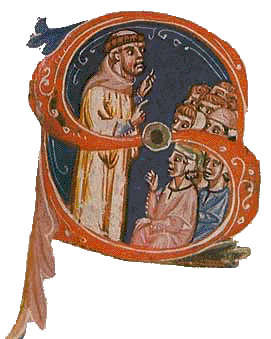Seven Liberal arts
on the archivolts of the south door, the Royal Portal. (1145-55)
三藝: 語法、邏輯、修辭 + 四藝: 算術、幾何、音樂、天文。
Hortus Deliciarum
Fulbert (970-1028)
Fulbert (c.960-1028), is generally recognized as the man who
put Chartres on the map of medieval education. Fulbert came to
Chartres about 990, and for about ten years was an assistant in
the cathedral school which was to prepare young men for the
clerical life. There was no ideal of a general secular
culture. The course of studies was based on the liberal arts, and
Fulbert himself seems to have known some medicine. Chartres was
not the only center of learning during the time of Fulbert, and
the schools at Liège and Cologne were undoubtedly more advanced
in mathematics than was Chartres.
Fulbert became bishop of Chartres
from 1006 until his death 22 years later. - - - Clamor 詛咒
Life of Fulbert

MUTUAL DUTIES OF VASSALS AND LORDS
- a letter by Bishop Fulbert, 1025
Yves (1040-1115)
Saint Ivo (Yves) of Chartres was an important
canon lawyer during the Investiture Crisis.
As bishop of Chartres from 1090 until his death and a canonist he contended
strongly against simony and opposed King Philip I's repudiation
of his wife in order to marry Bertrade of Anjou
in 1092. Ivo was briefly imprisoned for his opposition.
Three extensive canonical works—Tripartita, Decretum, and
Panormia—are attributed to Ivo. He is not
known when or whether he was ever officially canonized.

a letter transferring a penitent to the Pope
Fulcher of Chartres(1059-1127)

The First Crusade - The Chronicle of Fulcher of Chartres by Fulcher of Chartres
Historia Hierosolymitana (Latin) by Fulcher of Chartres
Primary Sources of the First Crusade
西方人都變成了東方人

crusader bishops
Medical school of Salerno

The School of Chartres - by Ralph McInerny

* * *
The Renaissance of the 12th century
A period of many changes
at the outset of the High Middle Ages. It included social,
political and economic transformations, and an intellectual
revitalization of Western Europe with strong philosophical and
scientific roots.
scripture and nature
integumentum (wrapping): form and content
exegesis: letter and spirit
allegory, parables
paradise to paradigm (eternal model)
order and prophecy
Gilbert de la Porrée (1076–1154)

French scholastic philosopher, was born in Poitiers.
He taught for 20 years at Chartres, where he was for some time chancellor.
He later lectured at Paris. In 1142 he was made bishop of Poitiers.
He was twice accused of heresy.
Gilbert's works — "De sex principiis", an elucidation of Aristotle's last six categories,
and his commentary on the "De trinitate" ascribed to Boethius — reveal his somewhat obscure position
in scholastic realism, to which he adhered in a moderated form.
His doctrine of the Trinity caused considerable debate.
He maintained that one can not say that only God is both Father, Son and Holy Spirit,
or that divinity has become flesh.
In 1147, two priests of his diocese considered this saying a "tritheism" and denounced this doctrine at a council held in Paris.
The following year, the charge is taken before the Council of Reims and supported by Bernard of Clairvaux,
but the charge was not against Gilbert personally or his doctrine.
He received kind testimonies from the pope and retains his bishopric position.
Heretic or hero? Posthumous representations of Gilbert of Poitiers in texts and images before 1200
- Laura Cleaver
Is Gilbert of Poitiers’ approach to the problem of linguistic reference a pragmatic one?
- Luisa Valente
Thierry of Chartres (? - 1150)
A philosopher working at Chartres and Paris. The cathedral
school at Chartres promoted scholarship before the first
university was founded in France. Thierry was a major figure
in 12th-century philosophy and learning, and is notable for
his embrace of Plato's Timaeus and his application of
philosophy to theological issues. Thierry became chancellor
of Chartres after his predecessor, Gilbert of Poitiers,
returned to his native city in 1141. John of Salisbury was
one of Thierry's students.
Metaphysics of Unity in Thierry of Chartres On the philosophy of nature and theology in the twelfth century - by Klaus Riesenhuber
Nature as object of science - by Carlos Steel
John of Salisbury (c.1120-1180)
and was born at Salisbury, studied in Paris under Peter Abelard
and later studied theology under Gilbert de la Porrée.
He became the secretary to Theobald, archbishop of Canterbury. After the death of Theobald in 1161,
John continued as secretary to Thomas Becket. He wrote a Life of Becket.
In 1176 he was made bishop of Chartres, 4 years before his death.
John's writings clarify the literary and
scientific position of 12th century Western Europe. His doctrine is a kind of utilitarianism, with
a strong leaning on the speculative side to the modified
literary scepticism of Cicero, for whom he
admired and on whose style he based his own. His view
that the end of education was moral, rather than merely
intellectual, became one of the prime educational doctrines
of western civilization.
Metalogicon - by John of Salisbury(c.1120-1180)
Thou shalt not slay a tyrant - by Jan Van Laaarhoven
John of Salisbury as Classical Scholar - by Janet Martin
John of Salisbury and Thomas Becket - by Ann Duggan
opera omnia
Manuscripts in Chartres - by Charles Burnett
The Cathari (1140-1330)
The essential characteristic of the Catharist faith was Dualism, i.e.
the belief in a good and an evil principle, of whom the former created
the invisible and spiritual universe, while the latter was the author of
the material world. Their perfect equality was admitted by the
absolute Dualists, whereas in the mitigated form of Dualism the
beneficent principle alone was eternal and supreme, the evil principle
being inferior to him and a mere creature. The Cathari were rigid
Dualists.
By about 1140 the Cathar Church of the Languedoc established a liturgy and a system of doctrine.
It created the first bishopric at Albi around 1165 (hence the
term Albigensians) and by 1200 there were 4 bishoprics including Toulouse, Carcassonne, and Agen.
The Catharist system was a simultaneous attack on the Catholic Church
and the then existing State. The Church was directly assailed in its
doctrine and hierarchy. The denial of the value of oaths, and the
suppression, at least in theory, of the right to punish, undermined the
basis of the Christian State. According to the Catharist doctrine, all intercourse between
the sexes ought to be avoided and that suicide
or the Endura, under certain circumstances, is not only lawful but
commendable.
The members of the sect were divided into two classes: The "perfect"
(perfecti) and the mere "believers" (credentes). The "perfect" were
those who had submitted to the initiation-rite (consolamentum). They
were few in number and were alone bound to the observance of the
rigid moral law. While the female members of this class
did not travel, the men went, by twos, from place to place, performing
the ceremony of initiation. The only bond that attached the "believers"
to Albigensianism was the promise to receive the consolamentum before
death. They could marry, wage war, etc., and
generally observed the ten commandments. Many remained "believers" for
years and were only initiated on their deathbed. If the illness did not
end fatally, starvation or poison prevented rather frequently subsequent
moral transgressions.
The hierarchy consisted of bishops and deacons. The bishops were chosen
from among the "perfect." They had two assistants, the older and the
younger son (filius major and filius minor), and were generally
succeeded by the former.
The Albigensian Crusade or Cathar Crusade (1209–1255) was a
military campaign initiated by the Catholic Church to eliminate
Catharism in Languedoc. The Crusade was prosecuted primarily by the
French crown. When Pope Innocent III declared the crusade
against Languedoc, he offered the lands of the Cathar "heretics" to any
French nobleman willing to take up arms. The Albigensian Crusade also had a role in
the creation and institutionalization of both the Dominican Order and
the Medieval Inquisition.
the Inquisitor's Manual of Bernard Gui [d.1331]
.jpg)
Representation of an auto-da-fé, presided over by St. Dominic (around 1495).
* * *
Choir screen 40 scenes
9 types of angels
Stained glass windows a chronology
curiosities
READING REPORTS on 10th August, 2012.
|





